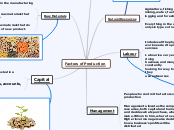How to solve
math problems
This is a collection of ideas on math problem solving.
Here are some highlights:
The map offers
• hints on notetaking for math,
• a large collection of math tools,
• several new techniques for math creativity,
• internet resources.
about this map and
the author
about
the author
Thomas Teepe,
• born 1971,
• doctoral thesis on Genetic Algorithms in applied math,
• works as an actuarial consultant,
• lives in Stuttgart, Germany.
•
Feedback on this Mindomo map is very welcome.
Please write to thomasteepe@web.de.
changes
to this map
03.03.2010: First draft
07.03.2010: Collection of math tools added
30.03.2010: Additions to "Combining notetaking and tools", smaller changes to other text notes
15.10.2010: Some minor changes - branch names
combining notetaking
and tools
The basic idea is to finetune notetaking techniques and math problem solving tools.
Here are a number of ideas.
change between mind maps
and conventional math notes
Some parts of math problem solving work better in a framework of conventional, linear math notes, others in mind maps.
Linear notes are for example good for
• manipulating equations,
• computations.
Mind maps are for example good for
• collecting approaches,
• dealing with obstacles.
tools for
math problem solving
Tricki
The Tricki was started by Fields medalist Timothy Gowers.
From the start page:
"Welcome to a brand new Wiki-style site that is intended to develop into a large store of useful mathematical problem-solving techniques. Some of these techniques will be very general, while others will concern particular subareas of mathematics. All of them will be techniques that are used regularly by mathematical problem-solvers, at every level of experience. (...)"
special
math tools
This branch contains a number of ideas on solving math problems.The map deals with general problem solving tools that are not specific for one area, e.g. you will find nothing specific on dealing with polynomes or inequalities.
Most of the ideas are taken from the following sources:
• Engel, Arthur: Problem Solving Strategies
• Polya, George: How To Solve It
• Zeitz, Paul: The Art and Craft of Problem Solving
staying functional during problem solving
persist
breathe deeply and calmly
remember previous successes
exercise
eat / drink something
work in a new setting
take a break
talk to someone
getting information
use the internet
use math databases
use newsgroups
use forums
e-mail people
use literature
journals
books
math reviews
ask people
experts
fellow students
teachers
analysis
tools
analyzing:
look for "SPLENDID"
To memorize common methods of analyzing math problems, we use the keyword SPLENDID - it stands for
•
• S: look for SYMMETRIES
• P: look for PATTERNS
• L: look at LIMITS
• E: look at EXTREME cases
• N: is a rather useful letter in this keyword;-)
• D: collect DATA
• I: look for INVARIANTS
• D: take a more / less DETAILED look
creativity
tools
basic concept:
combine
OBJECTS and ACTIONS
Combining OBJECTS and ACTIONS is basically a math creativity technique:
It leads to a large number of seminal ideas to tackle a (math) problem.
The underlying ideas are of course not restricted to m a t h problem solving.
ACTIONS: "SCREAM"
To make the actions easier to memorize, we use the keyword "SCREAM" - it stands for
•
• S: substitute
• C: combine; create
• R: rearrange; reverse
• E: eliminate
• A: adapt
• M: modify; magnify, minimize
(This is largely inspired by Michael Michalkos "SCAMPER" creativity technique.)
You may have guessed that I'm not a native speaker of English. So if someone comes up with better keywords - help is greatly appreciated.
OBJECTS
search direction
backward
forward
math objects
inequalities
equations
realtions
matrices
sets
numbers
functions
general math tools
series
graphs
complex numbers
representation of the problem
Finding an appropriate representation of a problem is often crucial for finding a solution.
Example: A problem may be very ugly in cartesian coordinates, but can be treated nicely in polar coordinates.
algorithms
geometry
coordinate systems
number representation
...
binary
number systems
algebra
proof techniques
These proof techniques are standard. More information can be found in
Arthur Engel: Problem Solving StrategiesPaul Zeitz: The Art and Craft of Problem Solvingusing symmetry
pigeonhole prinicple
using extremal cases
using invariance
by induction
by contradiction
by direct proof
problem elements
From a v e r y abstract point of view, a problem consists of
the unknownthe data andthe condition.This idea is taken from George Polya's "How to Solve It".
What is the condition?
What are the data?
What is the unknown?
tools:
some basic topics
representing tools
OK, you've learned a number of tools.
How to make sure you have these tools ready when you need them?
Here are a number of ideas.
- Just trust your memory.
- Use acronyms - here's an example:
SCAMPER stands for
S substituteC combine with other ideasA adaptM maximize, minimizeP put to other usesE eliminateR rearrange- Use written collections of tools. This is my favourite method - even the initial act of writing down such a collection can give you so much insight into your problem solving behaviour.
arranging tools
Here are several methods for arranging tools.
These methods work best when used in combination - one single method won't do.
You may arrange problem solving tools
- by problem solving stages:
One of the most famous examples of problem solving stages comes from George Polya's classic "How to Solve It":
Understand the problemDevise a planCarry out the planLook backTo each of these stages you can add a number of useful tools.
- by subject matter:
You can collect tools that help to deal with
sequences, series, vectors, functions,...- by problem solving difficulties:
You can make a collection of your most frequent problem solving difficulties and then add tools as remedies.
math problem solving tools
- a definition
Here's a definition, naive yet useful:
A math problem solving tool is anything that may help you to solve a math problem.
Obviously, this concept is not limited to math.
Here are some examples:
draw a diagram,
collect data from examples,
consider special cases,
look for invariants, symmetries, patterns...,
apply the mean value theorem,
search the internet,
talk to a friend,
e-mail an expert,
have a break.
how to
take notes
Most books on math problem solving I know offer few information about notetaking.
Here are some ideas.
Links
Wikipedia: Mind Mapping
Wikipedia: Notetaking
notetaking equipment
Notetaking starts with materials.
Here are some ideas.
computers & graphic tablets
Solving math problems typically involves things like
• using math notation, often in intricate computations,
• collecting data and arranging them in tables,
• drawing figures and diagrams.
I doubt whether it is possible to produce all this quickly with keyboard and mouse.
Using a tablet PC or a graphic tablet may be well worth a try.
Here are some possible advantages:
• have all the possibilities of ordinary pen and paper notes,
• combine handwritten notes and prefab figures,
• highlight notes with colours, icons, frames etc.,
• erase notes,
• rearrange notes,
• change size of notes, minimize auxiliary material etc.,
• work on very large canvasses,
• hop from one canvas to another,
• work in collaboration with others on virtual whiteboards.
With the right support from software this could be very powerful. For example, imagine a giant canvas with lots of virtual Post-It notes which you can manipulate in all sorts of ways.
(In March 2010 I've downloaded a trial version of MS OneNote, which is part of the Office family. It looks very promising.)
pen & paper
Effective notetaking depends on putting lots of information on a single sheet of paper while keeping it well-structured and legible.
This points to a combination of large sheets of paper (A3 rather than A4) and pens that allow small or even tiny handwriting.
notetaking techniques
What's the kind of notetaking that supports math problem solving best?
Here are several approaches.
mixed layouts
Test
mind mapping
linear notes
what clever notetaking can do for you
Well-done notes can help
• to document your thoughts,
• to clarify your ideas ,
• to resume a chain of thoughts after a break,
• to support your memory,
• to combine thinking in words and thinking in images,
• to collect ideas quickly and examine them in more detail later,
• to create distance to your own thoughts,
• to show others your ideas.
All this is sounds obvious? Yes, but it poses some questions of "notetaking engineering":
What's the kind of notetaking that supports m a t h notetaking best, with all its special needs for notation, diagrams and lengthy computations?









